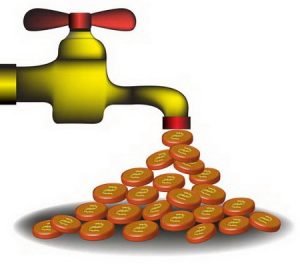by virtualworks | Sep 10, 2023 | Brand Image, Business, business growth, Customer relationships, Leadership, Marketing, Mastery, Productivity, Remote Office Management, Time Management, working from home, working remotely
 One of my favourite business books is “Raving Fans – A Revolutionary Approach to Customer Service” by Ken Blanchard and Sheldon Bowles. Published in 1993, the concepts in this book are as relevant today as they were then – perhaps even more so. One of the best ways to increase customer retention is to simply over deliver whenever possible. Giving your customers or clients more than they were expecting is a great way to keep them returning to your store or website (read: “raving fan”).
One of my favourite business books is “Raving Fans – A Revolutionary Approach to Customer Service” by Ken Blanchard and Sheldon Bowles. Published in 1993, the concepts in this book are as relevant today as they were then – perhaps even more so. One of the best ways to increase customer retention is to simply over deliver whenever possible. Giving your customers or clients more than they were expecting is a great way to keep them returning to your store or website (read: “raving fan”).
Who doesn’t like to get free stuff?
How can you over deliver to your customers as often as possible? Here are some unique customer service ideas to get you started (not surprisingly, it’s the little things that count and it doesn’t have to cost much).
- Give your customer a bonus, this could be a sample product, access to a coaching call or access to a private mastermind;
- Send them an article or a website link about something you know they’re interested in;
- Offer your customer a coupon for a discount on their next purchase. This also helps to get your customers visiting your store or website again. You could also offer a free sample, a consultation or a buy one get one free;
- If you offer a service, the best way to over deliver is to get the project finished ahead of time. Beating deadlines is a wonderful way to add value to your own offers and gain lifelong customers;
- Small gestures can go a long way in gaining appreciative customers. Sending a handwritten thank-you note by regular mail is one way to achieve this. Other small gestures include sending birthday and anniversary cards, or any number of other card ideas. (Tip: ‘Lumpy mail’ gets opened more often than flat mail…)
- Why not set up something such as a Customer of the Month or Customer Shout Out. Here you would thank your customer or highlight something they did that you thought was really cool;
- Invite them on an outing at your cost and go with them – a round of golf, a cycling trip, concert, festival. This is a fantastic way to build rapport with your customers and shows them you care.
Don’t forget to celebrate with your clients and customers and even fellow business owners. If they win a new contract or make a significant improvement in their business, send them a card or small gift. This sends the message that you’re paying attention.
Another fantastic way to over deliver to your present customers is to network with other business owners. Refer local businesses that offer quality services and products, which you do not carry. By doing this, you create resources for your customers and clients and you also help support local business. Always be sure to check out these sources first though because your reputation is on the line. You don’t want to recommend a bad resource or product to anyone.
by virtualworks | Aug 13, 2023 | Business, business growth, Customer relationships, Leadership, Marketing, Mastery, office management, Outsourcing, Productivity, Team Work, Time Management, Virtual Assistant, working from home, working remotely
 When you think of the most expensive admin assistant on the Planet, you might think of someone like Tony Stark’s assistant who puts up with all his quirks, but who is handsomely paid for her hardship. Or a billionaire’s assistant who is available 24/7 and at a moment’s notice may be called upon to drop everything and jump on a plane to Tokyo to attend meetings with their boss. You might think that…… and you would be wrong.
When you think of the most expensive admin assistant on the Planet, you might think of someone like Tony Stark’s assistant who puts up with all his quirks, but who is handsomely paid for her hardship. Or a billionaire’s assistant who is available 24/7 and at a moment’s notice may be called upon to drop everything and jump on a plane to Tokyo to attend meetings with their boss. You might think that…… and you would be wrong.
YOU.. yes.. you… are the most expensive admin assistant on the planet.
How can this be true? It’s because studies show that administrative tasks take up as much as 25% of an organization’s time.
So, what does this mean? Before we even talk about the dollar cost of this truth let’s talk about time. As a business owner, working a very conservative 60 hours a week, this equates to 15 hours per week. Which may not seem like that much, but how about when we look at the annual cost of this truth?
720 HOURS per year the average business owner spends on administrative tasks, that’s THREE MONTHS! Take that 720 hours and multiply by your client charge out rate. Not only is that a lot of money for doing back-office work that you shouldn’t be doing in the first place, it’s also money you haven’t billed because you’ve been doing “the paperwork”. If you outsourced these tasks alone at a much lower rate (hopefully) than you bill your clients, just think what you could do with an extra three month’s worth of time and a whole lot of extra money every year!!!
- How could your organization grow?
- What activities could you do with your family?
- How could you invest in your network and members?
- How could you serve your community?
If you have ever thought, “if only I had more time…” (you know that’s just an excuse, right?!?) and yet repeatedly find yourself burning the midnight oil filing invoices, inputting information into a database, updating your social media (or wishing you had time for social media)…
Everyone has the same 24 hours in a day so why not change things up and use those hours to full advantage?
by virtualworks | Jan 30, 2023 | Business, business growth, Marketing, Mastery, Team Work, Time Management, Value Based Fees
 When an organization needs to write a proposal, it can be for many different reasons, such as business proposals, project proposals, proposals for research funding or non-profit organization funding, each of which require a particular focus. Today I’ll focus on writing proposals in response to a solicited request, like contract work.
When an organization needs to write a proposal, it can be for many different reasons, such as business proposals, project proposals, proposals for research funding or non-profit organization funding, each of which require a particular focus. Today I’ll focus on writing proposals in response to a solicited request, like contract work.
All organizations need revenue, whether they are non-profits, associations or business enterprises. While it’s great to have repeat clients and members, there are times where organizations have to get out there and look for that work by other means and one method is by responding to a Tender, Request for Quotation, Request for Services, Request for Proposal, etc.
At times when an organization is provided with one of these Request documents, it can be met with some shock as to the amount of information being requested for a simple piece of work. Why so much detail? In short, some of the Requests may be from clients that use public funds and are accountable for how those funds are spent or the client is simply seeking good value for money and are looking for evidence from organizations that their potential contractor is capable of providing the services in a manner that is of good quality and is cost effective.
So, what makes a good proposal?
Like any consumer, the client is looking for good value for the money they plan on spending. By responding to what they are looking for, or solving their problem, stated in the request in a clear manner, a well written proposal can give you the edge on the competition.
There are many areas on the internet to find information on how to prepare a proposal. For example, if you are considering preparing a proposal for the Government of Canada, you may want to check out their site at buyandsell.gc.ca on Preparing Proposals.
Let’s take a look at some of the Do’s in proposal writing:
- Do read the request thoroughly to understand what the client is looking for. You need to understand where the client is coming from in their current state, their needs, and possible opportunities to provide a solution to their problem.
- Do ensure the goods or services are something your organization provides. If you are looking at a Request that is asking for something you may not provide, you may have to look at sub-contracting a portion of that work (if allowable), or it may not be worth your time to respond.
- Do ask questions where something is not clear, or you need information to help you prepare your proposal. These questions are helpful to the organization submitting a proposal and it may tell the client where they need to make the request clearer for all.
- Do watch out for question deadlines and submission deadlines – Proposals received after deadlines are usually not allowed.
- Do really take a look at the criteria in the Request. In most cases it is the criteria what your proposal will be reviewed against, so make sure to answer all parts of each criteria listed in the Request document.
- Do plan ahead to make sure there is enough time not only to write the proposal, but research the Client, understand the resources you have available, and have the proposal reviewed a few other people in your organization to make sure the submission is aligned with the Request. Another pair of eyes is always good!
The obvious Don’ts are those actions contrary to the Do’s above and:
- Don’t have the client search on external links for supporting material, especially if the request states that all supporting material must be in the proposal. In many cases, information from external sources can’t be taken into consideration and proposals are reviewed as they are provided, with no opportunity to add more in later. NB: some exceptions may be allowable, but they will probably be stated in the Request document, if they are.
- Don’t put it on your references to fill in the blanks of what should be in your proposal. If there is a request to provide references these are most likely only to verify what was stated in your proposal.
While it was mentioned above that Requests are received from clients, there are also many sites where organizations can search for potential Request documents to provide a proposal to such as MERX, Biddingo. Also check your city’s municipal, university, hospital or non-profit websites.
Best of luck in your proposal writing endeavors!
by virtualworks | Nov 19, 2022 | Business, business growth, daily lfe, Mastery, Productivity, working from home, working remotely
 I think it would be an understatement to say there is a lot of information from the news out there, at our fingertips through the newspaper, magazines and the internet, in our ears from the radio and as we sit to relax in front of the television
I think it would be an understatement to say there is a lot of information from the news out there, at our fingertips through the newspaper, magazines and the internet, in our ears from the radio and as we sit to relax in front of the television
Recently a friend of mine told me a story of how her sister was scanning through Facebook and came across an article that causes stress and anxiety for her sister, based on its content and coincidental applicability to events taking place in her life. In an effort to calm her sister she checked out the article discovering that it was not a recent publication and is what is referred to as “click-bait”, where an article provides a shocking title or introduction to lure people to read it and click on a link to another page, which in this case was to sell a product she didn’t need. This particular situation can be related to so many people facing a daily bombardment of information and requires us as consumers of information to ask the right questions.
If there is so much out there that is not reliable, why is news still important?
It is still important to know the facts about what is going on around us to help us make better decisions. This could include the simplest news like the weather person telling us its going to rain, so you make decisions to pack an umbrella, to changes in the stock of a corporation you are currently investing in. Also keep in mind that positive stories are still out there. It can brighten one’s day to read a story of a student who volunteers her time after school to set up activities in her local elder’s residence or community coming together to help out a family
How do we decipher the information coming in and why it is important to look into where news comes from?
When looking at a source of information there are a few best practices in determining the reliability of the information. Some of these can take some time and research, but if someone is really determined to measure the reliability of a source there are a few steps that can be taken. These can be quick checks such as verifying the date of the publication of the article is current, checking who the author is and doing a search of the author to determine if they have credentials in the field they are discussing and verifying the publication source. Further research could be in identifying the company or organization that is publishing this article, are they a known source, are they a source in the related field of the article topic? Finally, another level of research could include determining the organization’s place in the industry and what their best interests would be. For example, if you came across an article stating “Brand X” dog food is known to cause digestive illness in dogs and it is published by a communications division of “Brand Y” dog food, you might question what the motivation would be for this article. Is it to warn people, or have “Brand X” purchasers move over to “Brand Y”, increasing sales?
What responsibility does the reader have in distinguishing fact from fiction?
As the reader we need to watch what is real and what is not to ensure we are looking at information that is correct and to know our limitations in how much to take in, by understanding the cues from our emotions. If something induces a very negative emotion, it may be time to step away from that article, at least for the time being. Which leads us to…
When and why it is time to shut the news off?
As mentioned above, negative emotion can be your internal alarm to let you know when some news might just be enough and it may be important to interrupt the messaging being taken in at that time, to move onto something more productive and positive.
In these days of 24/7 information, give yourself permission to set boundaries around what is good for you and what is not good for you. You and your mental health are important!
by virtualworks | May 9, 2022 | Business, Case Study, Marketing, Mastery, Outsourcing, Value Based Fees

Did you hear the one about the customer and the plumber? This is a classic anecdote that applies to more and more industries and professions as we realize that providing services is not about trading time for money.
Customer: “Hello, I have a problem with my bathroom plumbing and I need you to come over.”
Plumber: “What seems to be the problem?”
Customer: “Well, when I flush the toilet, the kitchen faucet drips.”
Plumber: “I’ll be over this afternoon to have a look.”
The plumber arrives, inspects the plumbing in the house, checks out a few things, flips a few switches, tests the system and fixed the problem in about 15 minutes. He presents the customer with the bill.
Customer: “$600 to do 15 minutes work?!?!”
Plumber: “It took me 10 years to learn how to do that.”
There’s more to services than just trading time for money. What about all the years it took to get your education, training and credentials? What about your life experience? The time and effort it took you to build your organization? You’re worth so much more than dollars per hour. Think about it and share your comments.
by virtualworks | Jan 16, 2022 | Accomplishments, Business, business growth, Customer relationships, Leadership, Mastery, Public Speaking, remote meetings

Being invited to speak at an in person or virtual event can be a wonderful honour given to the potential speaker by those who want to hear the speaker’s message and share it with others. However, for some, it can be a great cause of anxiety and fear, with the thought that all those eyes will be on them and focused on everything that’s said.
The ability to be a good speaker doesn’t always go hand in hand with the ability to do it easily. It takes practice. I have spoken with many who are fantastic speakers, but they are extremely nervous before hand to the point of being physically ill. Just remember, if you are in this group of uneasy speakers, you’re not alone! So, then what? What can be done to make this easier, or at least get you through it?
Keep these few things in mind when getting ready to speak to a group when you may be feeling less than confident:
Your audience is there because they want to be: For the most part, people attending a conference, meeting or lecture are there because they chose to be there, they want to hear your message and will be supportive of your efforts. Attendees tend to not be judgmental, are not making snap decisions about you based on your haircut, clothes etc. and are there to hear what you have to say, even if they’re there not by choice (perhaps they have been instructed to go by their boss), these attendees, will most likely just listen politely.
Change your worry to excitement: This is a tough one because you’re so focused on the negative aspects of what you think may happen. What if you switched your thought process and redirected it to excitement at the possibilities of doing a great job? Go into it with a positive outlook and understand that even if it doesn’t go the way you want, you still did it! You would have accomplished a major step in your own personal development and that’s awesome!
Practice and prepare: Practicing the presentation before hand helps a lot. Try getting a small audience together or even just practice by yourself. Give yourself a few days in advance to do this. Go through and read your presentation, re-write if you have to and make a few speaking notes for yourself as a guide. By taking these steps to practice and prepare, you’ll be more familiar with the material, therefore making it easier to engage in a conversational type of presentation and making eye contact with your audience, instead of looking at your notes. Another great place to practice amongst a supportive group would be to contact your local Toastmaster’s group.
Know the environment: If you’re in-person, make yourself familiar with the presentation venue and environment so you’re more comfortable before speaking. Arrive ahead of time, sit in various places in the room for a few minutes to get different visual perspectives and get settled in. Own the space.
Interact with your audience: If you’re worried about the audience getting bored, make sure to leave room for people to ask questions. Listening to their questions can give you a little break as well to take a drink of water and re-group as needed. This can also help you gain some extra time on your presentation if it seems to be too short. Remember to be welcoming of questions and stay calm.
Take care of yourself: Get plenty of rest, eat well and taking the time to pamper yourself a little before the presentation day provides a little extra boost and don’t forget to give yourself a little time to use the restroom before the presentation. Make sure you have some water by your side to take sips to avoid a dry mouth while speaking. If possible, make sure you’re already standing up a few minutes before the presentation, so you don’t have to maneuver around obstacles to get to your place.
Are you in the audience? Perhaps you are reading this and are not a speaker, but frequently attend presentations. Why not do what you can to make the speaker feel confident and perhaps let them know what you enjoyed in their presentation? We’re all in this together. No matter the size of the group you are speaking to, you can do it and there are people in your audience that are in your corner. Be excited for this opportunity – you’ll do great!
 One of my favourite business books is “Raving Fans – A Revolutionary Approach to Customer Service” by Ken Blanchard and Sheldon Bowles. Published in 1993, the concepts in this book are as relevant today as they were then – perhaps even more so. One of the best ways to increase customer retention is to simply over deliver whenever possible. Giving your customers or clients more than they were expecting is a great way to keep them returning to your store or website (read: “raving fan”).
One of my favourite business books is “Raving Fans – A Revolutionary Approach to Customer Service” by Ken Blanchard and Sheldon Bowles. Published in 1993, the concepts in this book are as relevant today as they were then – perhaps even more so. One of the best ways to increase customer retention is to simply over deliver whenever possible. Giving your customers or clients more than they were expecting is a great way to keep them returning to your store or website (read: “raving fan”).





Recent Comments